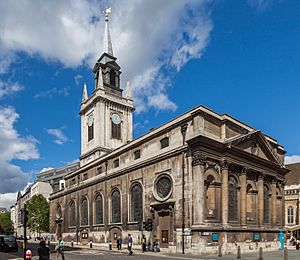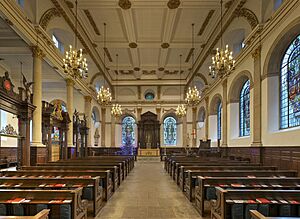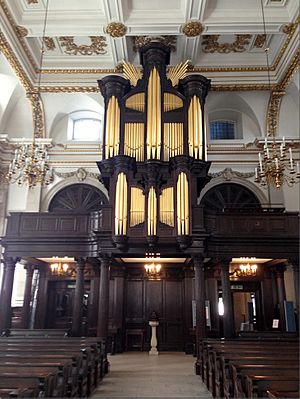St Lawrence Jewry facts for kids
Quick facts for kids St Lawrence Jewry next Guildhall |
|
|---|---|

St Lawrence Jewry from the south-east
|
|
| OS grid reference | TQ 32458 81325 |
| Location | London, EC2 |
| Country | England |
| Denomination | Church of England |
| History | |
| Dedication | St Lawrence |
| Architecture | |
| Heritage designation | Grade I listed building |
| Architect(s) | Christopher Wren |
| Style | Baroque |
| Administration | |
| Diocese | London |
St Lawrence Jewry next Guildhall is a special church in the City of London. It is part of the Church of England. You can find it on Gresham Street, right next to the famous Guildhall.
This church was sadly destroyed in the Great Fire of London in 1666. But it was rebuilt by the amazing architect Sir Christopher Wren. Today, it is the official church for the Lord Mayor of London.
Contents
History of the Church
Early Beginnings
The first church on this spot was built a very long time ago, in the 1100s. It was named after St Lawrence. If you look at the top of the church, you'll see a weathervane shaped like a gridiron. This is a symbol of how St Lawrence was martyred.
The church is also close to where Jewish people lived in medieval times. This area was called the "Jewish ghetto," and a street there is still named Old Jewry.
It's thought that the church's unusual position might be because it was built on top of an old Roman Amphitheatre. This ancient Roman building was only found in 1988. You can now visit its remains under the Guildhall Art Gallery. A famous person, Sir Thomas More, even preached in the old church here.
Rebuilding After the Great Fire
In 1618, the medieval church was repaired. All its windows were filled with beautiful stained glass. Different people paid for these windows.
However, the church was completely destroyed in the Great Fire of London in 1666. Sir Christopher Wren then designed a new church. It was built between 1670 and 1677. The new church was made entirely of stone. It has a grand front with tall columns and a triangular top part called a pediment.
Inside, Wren's church has a special design. It has an aisle on one side, separated by columns. The ceiling is decorated with sunken panels and patterns. The church is about 25 meters long and 20 meters wide.
Modern Times
During the Blitz in 1940, which was a time of heavy bombing in London during World War II, the church was badly damaged. After the war, the City of London Corporation decided to restore it. The church was carefully rebuilt in 1957 by an architect named Cecil Brown. He made sure it looked just like Wren's original design.
Today, St Lawrence Jewry is a "guild church." This means it doesn't have its own local area or "parish." It also doesn't have to hold regular Sunday services.
The church is considered a very important building. It was given a Grade I listed building status in 1950. This means it's protected because of its historical and architectural importance.
The church has eight bells that were made in 1957. Many important people were buried here, including John Tillotson, who was the Archbishop of Canterbury from 1691 to 1694.
The New Zealand Society UK uses the church for their Waitangi Day celebrations every February. This is a special day for New Zealand.
Catherine Ennis was the organist here until 2020.
See also
 In Spanish: St. Lawrence Jewry para niños
In Spanish: St. Lawrence Jewry para niños



